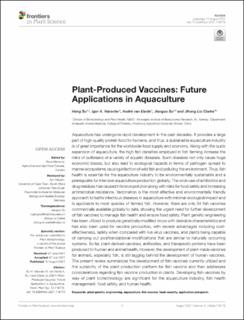| dc.description.abstract | Aquaculture has undergone rapid development in the past decades. It provides a large part of high-quality protein food for humans, and thus, a sustainable aquaculture industry is of great importance for the worldwide food supply and economy. Along with the quick expansion of aquaculture, the high fish densities employed in fish farming increase the risks of outbreaks of a variety of aquatic diseases. Such diseases not only cause huge economic losses, but also lead to ecological hazards in terms of pathogen spread to marine ecosystems causing infection of wild fish and polluting the environment. Thus, fish health is essential for the aquaculture industry to be environmentally sustainable and a prerequisite for intensive aquaculture production globally. The wide use of antibiotics and drug residues has caused intensive pollution along with risks for food safety and increasing antimicrobial resistance. Vaccination is the most effective and environmentally friendly approach to battle infectious diseases in aquaculture with minimal ecological impact and is applicable to most species of farmed fish. However, there are only 34 fish vaccines commercially available globally to date, showing the urgent need for further development of fish vaccines to manage fish health and ensure food safety. Plant genetic engineering has been utilized to produce genetically modified crops with desirable characteristics and has also been used for vaccine production, with several advantages including cost-effectiveness, safety when compared with live virus vaccines, and plants being capable of carrying out posttranslational modifications that are similar to naturally occurring systems. So far, plant-derived vaccines, antibodies, and therapeutic proteins have been produced for human and animal health. However, the development of plant-made vaccines for animals, especially fish, is still lagging behind the development of human vaccines. The present review summarizes the development of fish vaccines currently utilized and the suitability of the plant-production platform for fish vaccine and then addresses considerations regarding fish vaccine production in plants. Developing fish vaccines by way of plant biotechnology are significant for the aquaculture industry, fish health management, food safety, and human health. | en_US |

